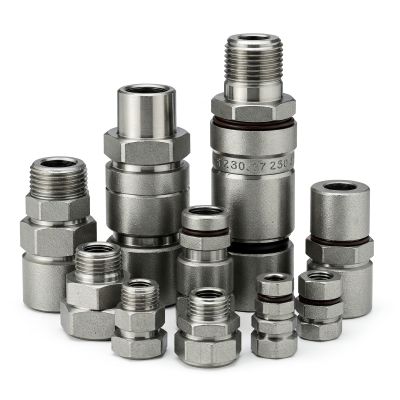Threaded fittings play a crucial role in plumbing, gas systems, hydraulics, and industrial applications. They ensure secure and leak-free connections between pipes and components, helping maintain system integrity. However, not all threads are created equal—different thread types are designed for specific uses and standards. Choosing the right thread type is essential to avoid compatibility issues, leaks, and system failures.
One of the most commonly used thread types is MPT (Male Pipe Thread), which is often confused with other thread types like NPT (National Pipe Thread), BSP (British Standard Pipe), UNF/UNC (Unified National Fine/Coarse Threads), and Metric Threads. This article will explore MPT threads, compare them with other common thread types, and explain their key differences.
What is MPT (Male Pipe Thread)?
MPT, or Male Pipe Thread, is a type of tapered thread used primarily in plumbing, gas lines, and hydraulic applications. The tapering of the thread allows for a secure and leak-resistant connection when properly tightened.
Characteristics of MPT Threads:
➡️ Tapered Design: MPT threads become narrower toward the end, creating a tighter fit when threaded into a corresponding female fitting.
➡️ Sealing Mechanism: Unlike parallel threads that rely on gaskets or O-rings, MPT threads form a seal by wedging into the female threads, sometimes requiring thread sealant for enhanced leak prevention.
➡️ Common Applications: Plumbing systems, gas lines, compressed air fittings, and hydraulic systems.
Common Thread Types and Their Characteristics
1. NPT (National Pipe Thread)
➡️ Similarities to MPT: Both are tapered pipe threads used primarily in North America for plumbing and industrial applications.
➡️ Key Differences: While MPT is often used interchangeably with NPT, technically, NPT refers to both male and female threads, whereas MPT specifies male threads only.
➡️ Sealing Properties: Requires thread sealant, such as PTFE tape or pipe dope, for a leak-free connection.
2. BSP (British Standard Pipe) Threads
➡️ BSPT (Tapered) vs. BSPP (Parallel): BSPT (British Standard Pipe Tapered) is similar to NPT/MPT but follows different standards, while BSPP (British Standard Pipe Parallel) has straight threads that require washers or gaskets for sealing.
➡️ Differences from MPT/NPT: BSP threads have different thread angles (55 degrees vs. 60 degrees for NPT/MPT), making them generally incompatible.
3. UNF/UNC (Unified National Fine/Coarse Threads)
➡️ Common Uses: Found in automotive, aerospace, and machinery applications.
➡️ Tapered vs. Straight: Unlike MPT/NPT, UNF/UNC threads are straight, requiring additional sealing methods like O-rings or gaskets.
4. Metric Threads
➡️ Common in European and International Applications: Used widely in manufacturing and machinery outside North America.
➡️ Key Differences: Measured in millimeters rather than inches, with both tapered and straight versions available.
Key Differences Between MPT and Other Thread Types
1. Tapered vs. Straight Threads
➡️ MPT Threads: Rely on tapering for sealing, creating a tighter fit.
➡️ Straight Threads (e.g., BSPP, UNF, Metric Parallel): Require additional sealing components like gaskets or O-rings.
2. Sealing Mechanism
➡️ MPT Threads: Seal by mechanical deformation of the threads, often supplemented with sealants.
➡️ Other Threads: Some rely on sealing materials (BSPP), while others require precise machining tolerances for proper fit.
3. Interchangeability and Compatibility
➡️ MPT vs. NPT: Often interchangeable but require caution due to slight variances.
➡️ BSP vs. MPT/NPT: Generally incompatible due to differences in thread angles and measurements.
➡️ Mixing Thread Types: Can lead to leaks, cross-threading, or damage to components.
4. Application-Specific Considerations
➡️ Plumbing and Gas Systems: MPT/NPT preferred for tight, leak-resistant connections.
➡️ Hydraulics and Industrial Applications: Metric or BSP threads may be required for international systems.
➡️ Regional Standards: Different countries have specific regulations governing thread compatibility.
Choosing the Right Thread Type for Your Application
1. Factors to Consider
➡️ Pressure Rating: High-pressure systems require reliable sealing mechanisms.
➡️ Material Compatibility: Thread materials (e.g., brass, stainless steel, plastic) impact performance.
➡️ Sealing Needs: Determine whether tapered threads or additional sealing elements are required.
2. Checking Specifications and Markings
➡️ Always verify markings on fittings and components to ensure compatibility.
➡️ Use manufacturer-provided specifications to confirm thread type.
3. When to Use Thread Sealants
➡️ PTFE Tape: Recommended for NPT/MPT threads to prevent leaks.
➡️ Pipe Dope: Provides a more permanent seal for high-pressure applications.
Conclusion
Understanding the key differences between MPT threads and other thread types is essential for ensuring proper compatibility, sealing, and system performance. Choosing the right thread type helps prevent leaks, component damage, and costly repairs. Always verify thread specifications before installation and use appropriate sealing methods for optimal results.
Post time: Mar-19-2025


